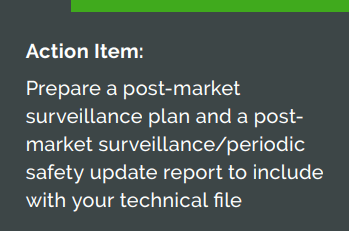The new MDR places greater emphasis on post-market surveillance (PMS) with the aim of continuously monitoring the quality, performance, and safety of a device throughout its entire lifecycle. PMS enables manufacturers to quickly identify issues with the design, manufacture, or use of the device and ultimately enhance patient safety.
Under the new regulations, manufacturers need to develop a PMS plan and report as part of their technical documentation.
The PMS plan should include:
- Proactive and systematic process for collecting data related to serious incidents, product trends, customer complaints, user feedback, etc.
- Effective and appropriate methods to assess collected data
- Indicators and threshold values for assessing risk-benefit and effective risk management
- Methods and tools for investigating complaints and other market-related information gathered in the field
- Methods and protocols to manage events subject to the trend report, as outlined in Article 88
- Protocols for communicating with competent authorities, notified bodies, economic operators, and users
- Reference to procedures that fulfill manufacturer obligations for the PMS system, PMS plan, and periodic safety update report (PSUR)
- Processes and procedures for implementing corrective actions
- Tools to effectively trace potentially defective products
The PMS reporting requirements will depend on the classification of the device.
Post-Market Surveillance Report (PMSR)
Post-market surveillance reports (PMSRs) are required for Class I medical devices. The PMSR should provide a summary of results and conclusions about post-market surveillance data defined in the PMS plan, as well as the rationale and description of any corrective or preventive actions taken. The report should be updated on an as needed basis.
.

Periodic Safety Update Report (PSUR)
Periodic safety update reports (PSURs) are required for Class IIa, IIb, and III devices. In addition to the information contained in the post-market surveillance report, the PSUR should also include key findings from the postmarket clinical follow-up (PMCF), conclusion of the benefit/risk determination, and data on sales volumes, user populations, and frequency of use. The report must be updated every two years (at minimum) for Class IIa devices and at least once a year for Class IIb and Class III devices.














